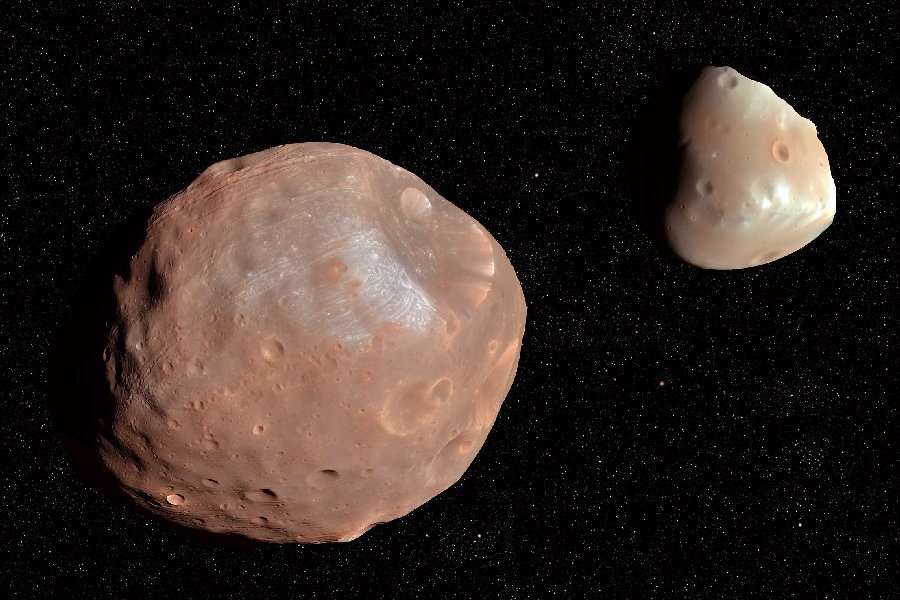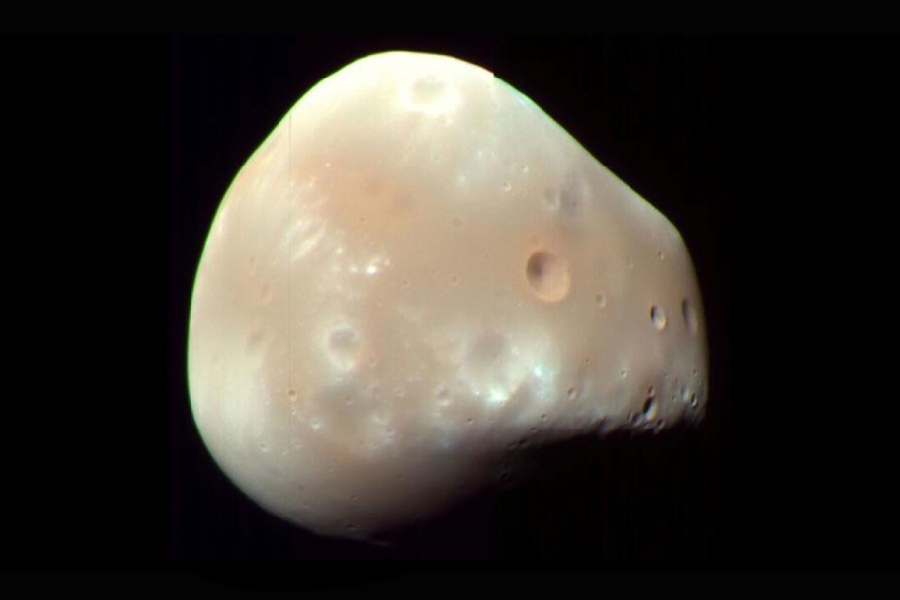Among cosmic questions captivating stargazers, one query persists around the mysterious Red Planet: how many moons does Mars have? Mars appears as a bright red star to observers on clear winter evenings. But could tiny satellites also orbit this harsh terrestrial world?
In exploring this enduring inquiry, we showcase the winding history linking the known Martian moons to alien origins from their host. We also highlight the race to explain tantalizing evidence. This evidence indicates that more moons yet lurk unseen, awaiting discovery.
This article summarizes current scientific insights about Mars‘ known moons and analyzes evidence for possibly undiscovered additional satellites. By reviewing existing knowledge and informed speculation, we aim to provide an informative reference.
How Many Moons Does Mars Have?
Mars has two small, irregularly shaped moons named Phobos and Deimos. These moons are significantly smaller than Earth’s moon. They are thought to be captured asteroids from the outer asteroid belt between Mars and Jupiter.
Phobos is the larger of the two, while Deimos is the smaller and more distant moon. The discovery of these moons dates back to the late 19th century. They play a role in the unique lunar system of the Red Planet.
But what are Mars moons named after? Phobos and Deimos, the Martian moons, derive their names from the Greek mythological twins associated with fear, panic (Phobos), terror, and dread (Deimos), who accompanied their father, Ares, into battle.

Counting the Moons: Unveiling the Martian Census
In the quest to understand Mars and its cosmic entourage, scientists embark on a meticulous process of counting its moons. This astronomical endeavor involves telescopic observations and data analysis to discern the presence and characteristics of Phobos and Deimos.
Early astronomers armed with telescopes initiated this celestial census in the late 19th century. This marked the beginning of our exploration into the Martian moon system.
Today, with advanced technologies and space missions, the process continues. It offers valuable insights into the dynamic dance of these Martian companions and the broader mysteries of our solar system.
Modern methods for counting Mars’ moons
Counting the moons of Mars in the modern day is a systematic and technologically sophisticated procedure. Here are the key aspects:
- Observational telescopes – Astronomers utilize powerful telescopes on Earth and in space to observe Mars and its surrounding celestial environment.
- Imaging techniques – High-resolution imaging techniques, including those employed by space probes like the Mars Reconnaissance Orbiter, capture detailed pictures of Phobos and Deimos.
- Data analysis – Advanced tools help scientists distinguish between background stars, other celestial objects, and the two Martian moons. This process ensures accurate identification and counting.
- Space missions – Dedicated space missions, such as the Mars Reconnaissance Orbiter, gather specific data about the moons’ compositions, surface features, and orbital characteristics.
- Collaborative research – International collaborations and shared observational data enhance the accuracy of moon counting and contribute to a more comprehensive understanding.
- Public engagement – Outreach initiatives involve citizen scientists in moon-counting projects, utilizing data from amateur astronomers. Public engagement enhances the scientific community’s ability to monitor and comprehend the Martian moons.
Meet Phobos
Phobos unveiled: Mars’ larger and closer moon
Mars’ larger moon, Phobos, orbits closer to its planet than any other solar system moon at 3,000 miles. Shaped like a potato and heavily cratered, Phobos completes three orbits under a Martian day, appearing to rise in the west like our own moon.
However, viewers on Mars could find it difficult to watch Phobos eclipse the Sun during the day because it is just 14 miles wide. While tiny, Phobos’ proximity makes it seem more prominent in Martian skies for hypothetical moon gazers.
The unique origins: Unraveling the mystery behind Phobos
Phobos orbits so close to Mars, contradicting how moons naturally form poses a head-scratching scientific mystery. The leading theory states that Phobos and fellow moon Deimos originate from a massive ancient impact with Mars that launched debris later re-accreting in orbit.
Another idea proposes that Phobos was captured by Mars’ gravity from an asteroid between Jupiter and Mars. Unusual grooves lining Phobos’ surface likely arise from ejected material splashing upwards in Mars’s tidal forces rather than asteroid collisions. So, ongoing studies aim to decode the past cataclysm that birthed this diminutive, oddly placed moon.

Deimos: The Distant Companion
Deimos’ silent orbit
Deimos circles the planet at a much greater distance of 14,000 miles in a near-polar elongated orbit. At just under 10 miles wide, this irregularly shaped satellite takes 30 hours to complete an orbit. This means it appears to rise in the east and set in the west each night, similar to Earth’s Moon.
Deimos’ tiny form and distance also mean hypothetical future colonists would struggle to view it without a telescope unless timing perfectly closer passes. Like Phobos, unraveling Deimos’ origins is likely tied back to titanic impacts. Debris scattered later was swept up by Mars’ gravity, eventually forming this diminutive, inert world.
Composition and characteristics
Deimos’s small, lumpy form focuses on an approach for a potential sample return mission. This distant orb presents a pale red surface in color closely matching the Martian regolith below.
It suggests Deimos coalesced from impact ejecta in the planet’s early days soon after its formation. From patterns in its craters to the occasional shedding of boulders in Mars’ gravity, Deimos gives up secrets into its past and identity as an irregularly shaped moon.
Though cold and muted compared to more active asteroids, Deimos shines a light for astronomers. It connects the dots into Mars’ earliest eras and mightiest collisions still reverberating today.
Martian Moon System: A Brief Overview
Comparing Mars’ moons to Earth’s moon
Mars hosts two tiny irregular moons – Phobos and Deimos- unlike the single large moon orbiting Earth. In contrast to our moon’s 2,160-mile diameter and steady, far-flung orbit, Phobos and Deimos span under 16 miles wide in lumpy asteroid-like shapes. Earth’s moon circles over 200,000 miles away, allowing perfect solar eclipses.
But Phobos races around Mars at a paltry 3,700 miles where it couldn’t fully eclipse the Sun from Mars’ surface. Meanwhile, Deimos’ even smaller form slowly creeps around the planet at a considerably further 14,000-mile distance, more like our own Moon’s orbital circumference.
Yet even Deimos couldn’t produce a total Martian solar eclipse, but perhaps dimming as it partially screens the Sun. Beyond their tiny sizes, the irregular Physics of Mars’ two moons paints them as products of calamity rather than the familiar serene order.
Understanding Phobos and Deimos’ orbits
The rapid 53-hour and leisurely 30-hour orbits of Phobos and Deimos, respectively, mean both rotate around Mars faster than their parent planet’s 24-hour spin cycle. This results in their unusual rising in the west and east patterns from observers on Mars.
However, tidal forces between Mars and Phobos continue to tighten the latter’s orbit. This results in decay marked by prominent tell-tale surface grooves aligned with the gravitational forces.
Calculations indicate Phobos will eventually either tear into a ring structure or directly crash into Mars tens of millions of years. It is a reminder of the dynamic and impermanent nature of moon systems shaped over eons by delicate gravitational forces.
Martian Moon Phases and Eclipses
Phobos’ rapid orbits: Martian moon phases
Phobos circles Mars so swiftly in just seven hours and 39 minutes that an observer would witness truly bizarre moon phases by terrestrial standards. Full phases of Phobos seen from the Martian surface would transition to complete in under four hours. It is over 18x faster than Earth’s leisurely lunar cycle between full moons.
Future colonists could witness the rocky, irregular bulk of potato-shaped Phobos swell from a thin crescent to a full three times in barely half a Martian day. After this mesmerizing display, it would then wane once more.
More curiously still, an observer on Phobos looking back would see Mars go through a complete full phase cycle twice each “day” from their vantage point. This is due to the inner moon’s rapid orbital period relative to Mars’ 24-hour rotation. This breakneck lunar choreography makes eclipse predictions challenging but spectacular for future astronauts under alien skies.
Moonlit skies: Eclipses on Mars seen from Phobos and Deimos
While too small to fully eclipse the Sun or Mars, observers on Phobos would still witness Deimos partially masking the Sun roughly once per year as projection alignments permit. For hypothetical visitors on Deimos gazings back, Phobos appears large enough to transit across and even partially occult Mars almost daily.
Total solar eclipses also occur on Mars when Phobos fully mask the Sun. Still, only brief minutes in limited locales rather than the hours-long spectacles across half a world terrestrial eclipses enable. The tiny moons still introduce remarkable eclipse signatures beyond Earthly experience through this complex orbital dance.
Conclusion
As we conclude an intriguing exploration of Mars’s cosmic family, we have traversed a winding journey around the question: how many moons does Mars have?
Glimpsing Phobos and Deimos against today’s ruddy skies, we reflect on eras when titanic impacts created this petite pair. Now, we better appreciate the complexity underlying such a simple numeric query.
So, whether Phobos and Deimos remain lone satellites or merely heralds of additional moons awaiting discovery, the unveiling of Mars’s cosmic family ancestry may continue advancing our place in the universe’s grand arena.
